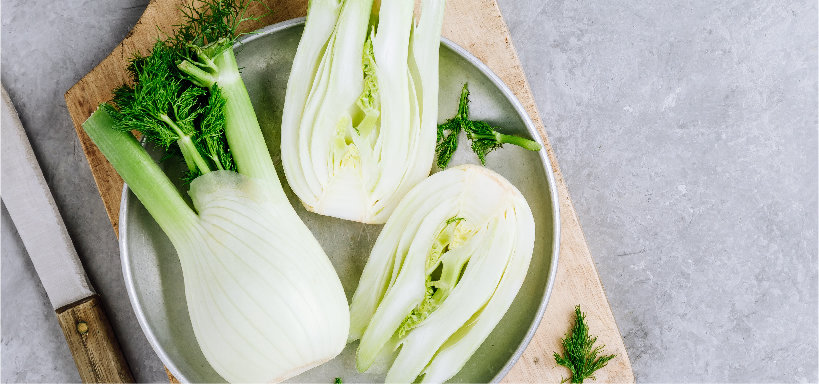
You may know of it as a flavoring agent in sambuca and absinthe, or maybe your grandmother sliced fennel bulb for you as a remedy for gassiness and indigestion. It turns out fennel has actually been used for its nutritious properties since ancient times, and it plays an important role in traditional medicine.
In the ancient world, the Romans, Greeks and Egyptians used fennel as part of their ceremonies. It served as a symbol of wellness and pleasure.
It has also been valued for its ability to soothe digestive complaints for thousands of years.
Today, this popular vegetable continues to be one of the most widely used herbal plants. Fennel essential oil and all parts of the plant are used for cooking, baking and as medicine for more than 40 types of disorders.
With its anti-inflammatory, antimicrobial, antiviral, anti-tumor and antispasmodic properties, just to name a few, it’s obvious why fennel has been viewed as a valuable plant for thousands of years.
What Is Fennel?
Fennel is a celery-like winter vegetable with an interesting licorice-like flavor. Although the taste may take some getting used to at first, fennel provides an enormous amount of health benefits.
The plant originated in the Souther Mediterranean region and through cultivation began to grow wild throughout the Northern, Eastern and Western hemispheres. The scientific name for fennel is Foeniculum vulgare.
It’s an ancient perennial herb that has feathery leaves and yellow flowers, looking a bit like dill weed. Fresh fennel is known for its highly aromatic properties, smelling a bit like anise, but with warm and woody undertones. The peak growing season for fennel is autumn and winter.
Fennel is recognized by its white bulb and long green stalks. It is related to other stalk vegetables, such as celery and parsnips. The entire fennel plant is edible, including the bulb, seeds, stalk and leaves.
The bulb can be chopped and added to salads, slaws, pasta dishes and more. It adds a crisp and crunchy texture to any dish and a sweet flavor.
The bulb contains a number of phenolic compounds, including bioflavonoids, phenolic acids, tannins, coumarins and hydroxycinnamic acids.
Fennel seeds are rich in flavonoid antioxidants, and they contain a concentrated source of micronutrients. The seeds are also used to make fennel essential oil, first by crushing them and then using a process called steam distillation.
Fennel has been used in many cultures for its medicinal properties. Since the time of Hippocrates, it was used as medicine.
The Romans thought of fennel as a sacred ritual object, and they used it as a digestive stimulant. The Greeks used fennel during their ceremonies because it symbolized pleasure and prosperity, and the ancient Chinese and Egyptians used the vegetable as food and medicine.
In traditional Chinese medicine, it is used to help with a variety of ailments from congestion to helping increase the flow of breast milk. It can also help with stomach upset, insect bites and soothe a sore throat.
In Ayurvedic medicine, it’s used because of its warming properties. It’s thought to help balance all of the body types, including vata, pitta and kapha. It’s considered nourishing to the eyes and brain and known to relieve digestive complaints, like gassiness.
The herbal plant is also used in other traditional systems of medicine, including Unani, Siddha, Indian and Iranian systems. Reports indicate that in traditional medicine, fennel is used to treat a range of ailments, from simple issues like the common cold and cough to more complicated conditions, like cancer, arthritis, colic, abdominal pain, diarrhea, constipation, liver pain and kidney issues.
Nutrition Facts
One average, raw fennel bulb (about 234 grams) contains approximately:
- 72.5 calories
- 17.1 grams carbohydrates
- 2.9 grams protein
- 0.5 grams fat
- 7.3 grams fiber
- 28.1 milligrams vitamin C (47 percent DV)
- 969 milligrams potassium (28 percent DV)
- 0.4 milligrams manganese (22 percent DV)
- 63.2 micrograms folate (16 percent DV)
- 117 milligrams phosphorus (12 percent DV)
- 115 milligrams calcium (11 percent DV)
- 39.8 milligrams magnesium (10 percent DV)
- 1.7 milligrams iron (9 percent DV)
- 0.2 milligrams copper (8 percent DV)
- 1.5 milligrams niacin (7 percent Dv)
- 314 international units vitamin A (6 percent DV)
- 0.1 milligrams vitamin B6 (5 percent DV)
- 0.5 milligrams pantothenic acid (5 percent DV)
- 0.1 milligrams riboflavin (4 percent DV)
Fennel Benefits
1. Boosts Bone Health
Due to the calcium content, fennel can help maintain bone strength and health. One cup of fennel contains about 43 milligrams of calcium, which can be helpful for those who don’t cook with enough foods high in the nutrient and may have a calcium deficiency.
Research shows that increasing calcium intake from dietary sources increases your bone mineral density.
Calcium isn’t the only bone-strengthening nutrient found in the bulb. Fennel also contains magnesium, phosphorus and vitamin K, which all play a role in maintaining bone strength.
2. Improves Skin Health
Fennel is high in vitamin C, providing almost half of the recommended daily allowance in just one bulb. This nutrient is a potent antioxidant that may help reduce the free radical damage that can lead to premature aging.
Research suggests that ascorbic acid is also necessary for the formation of collagen and a powerful tool in protecting skin’s appearance, making it an excellent choice to naturally slow aging. A deficiency in it is called scurvy, which manifests in the inability to properly form collagen, leading to bleeding gums and bleeding below the skin.
Due to these functions, adequate intakes of ascorbic acid are critical for reducing the appearance of wrinkles and maintaining healthy skin. The RDA is 60 milligrams per day, and consuming more of it from whole food sources, like fresh fennel, will help keep your skin healthy from the inside out.
3. Lowers Blood Pressure
Fennel can help lower blood pressure and inflammation due to its high potassium content and low sodium content. Potassium works against sodium, helping fight high blood pressure in the body.
Eating a diet that includes healthy potassium foods can reduce systolic blood pressure significantly when compared to a high-sodium diet. However, don’t expect lower blood pressure overnight. It takes about four weeks of consuming a high-potassium diet to see a drop in blood pressure.
4. Aids Digestion
Fennel is included in the GAPS diet because of its ability to ease digestion. Since fennel contains seven grams of dietary fiber, it can help maintain a healthy digestive system.
The muscles in the digestive system need foods like fennel to provide bulk for the gastrointestinal muscles to push against and increase motility or movement. Because digestive problems like constipation and IBS are so common in adults, fennel makes a great addition to any diet.
Additionally, fiber acts like a small brush as it moves through the digestive system, clearing the colon of toxins that could potentially cause colon cancer. Fennel itself can act like a laxative, helping with elimination of toxins.
Research published in the International Journal of Food Sciences and Nutrition indicates that fennel has a substantial body of data to support its digestion-enhancing activities. Researchers also point out ginger, peppermint, citrus fruits, dandelion and chamomile for their ability to aid digestion as well.
It is also common in certain cultures to chew fennel seeds after meals to help digestion and eliminate bad breath. Some of the oils found in fennel help stimulate the secretion of digestive juices.
Fennel may also be beneficial for people with acid reflux. Adding it to your diet can help balance the pH level within your body, especially within your stomach, and can reduce reflux after meals.
5. Increases Satiety
Fiber contains no calories but provides bulk, thereby increasing satiety. Humans do not have the enzymes required to break down fibrous foods — therefore it cannot be absorbed as calories.
Studies show that diets high in fiber can help people effectively lose weight. A 2001 study found that participants who added 14 grams per day to their diets, without changing anything else, ate approximately 10 percent fewer calories per day and lost about four pounds over a period of four months.
READ RELATED: How to Do the Perfect Russian Twist Exercise to Really Fire Up Your Core
Adding fennel to your diet may be a simple way to effortlessly feel more satisfied and possibly experience weight loss.
6. Improves Colic
Infant colic, although a relatively benign medical condition, can have a significant impact on new parents.
Fennel oil has been shown to reduce pain and increase motility in the small intestine, making it can excellent natural remedy for colic. It also helps calm the infant and reduce abdominal distension.
In a 2003 study, researchers compared fennel oil with a placebo in 125 infants. The group treated with fennel was reported to have 65 percent less colic, measured by crying episodes, than those in the control group with no side effects.
Although this research may be promising and many desperate parents may want to run out and get some fennel, there is not an established safe dose for infants at this time. The safest way to use it to treat infant colic is for a breastfeeding mother to drink fennel tea.
7. Helps Prevent Cancer
Fennel has been used for centuries in Chinese medicine to help treat inflammatory conditions such as insect bites or sore throat. Its ability to decrease inflammation led researchers to investigate if its properties could be applied to other inflammatory diseases, including various forms of cancers.
Fennel contains an oil called anethole that has been shown in some clinical studies to act as a natural cancer treatment, helping reduce the growth of breast cancer cells. It is believed that anethole reduces inflammation that may lead to the development of cancer, although further research is needed to determine how it can be used exactly.
Other anti-inflammatory nutrients are also found in fennel, specifically selenium, a trace mineral that may help decrease cancer mortality rates. A large study of over 8,000 participants found that selenium did reduce mortality and decrease future incidences of cancer.
8. Decreases Risk of Heart Disease
Fibrous foods have been shown to help reduce cholesterol levels in the bloodstream. They can help reduce the overall risk of heart attacks and stroke by helping lower blood cholesterol to a normal level.
In 2018, a study published in the Journal of Menopausal Medicine found that when postmenopausal women used fennel to improve their cholesterol, it resulted in a slight positive change in LDL and HDL cholesterol, along with triglyceride levels.
The fiber and potassium content make fennel a double whammy in reducing risk of cardiovascular disease by lowering both cholesterol and blood pressure. Fennel is also high in other potentially cardioprotective nutrients, such as folate and vitamin C.
9. Eye Health
Macular degeneration is the leading cause of age-related vision loss. Although the exact cause is unknown, antioxidants that help reduce inflammation, such as certain flavonoids, vitamin C and zinc, may help improve vision or slow the progress of the disease.
Fennel contains many of these vision-saving nutrients. Due to its high flavonoid, vitamin C and mineral content, it can help reduce oxidative damage and inflammation and may help prevent macular degeneration.
10. May Ease Menopausal Symptoms
A 2017 study in Menopause suggests that the use of fennel, a phytoestrogen, may contribute to improvements in menopausal symptoms. Researchers analyzed 90 women, ages 45 to 60, who had been postmenopausal for at least one year (no more than five years) and had at least moderate menopausal symptoms. Participants either received fennel or placebo capsules daily for eight weeks.
Fennel recipients saw significant improvements in symptoms, whereas placebo recipients did not. Researchers concluded that fennel may help ease menopausal symptoms in women with low estrogen levels as well as those who have experienced early menopause or have had a hysterectomy or oophorectomy. A larger trial, however, is needed to confirm these findings.
A 2018 systematic and meta-analysis published in the Journal of Menopausal Medicine found that when fennel is used to relieve menopausal symptoms, it helps reduce vaginal itching, dryness, sleeping issues and vasomotor symptoms, like night sweats, flushes and hot flashes. Fennel also helped improve sexual function and sexual satisfaction.
11. Stimulates Breast Milk Production
Fennel is used as a galactagogue agent for women who are breastfeeding. Galactagogues increase the production of breast milk.
Although the research on whether or not fennel is effective for promoting the production of breast milk, studies indicate that many women who do choose to use herbs as natural galactagogues tend to try fennel, milk thistle and goat’s rue most often.
Related: What Are Nigella Seeds? Top 5 Benefits + How to Use
Fennel vs. Anise vs. Licorice
Fennel
- Fennel is a plant in the carrot and celery family. It tastes similar to anise and is also highly aromatic.
- It contains anethole, an aromatic compound that’s believed to help fight off cancer, inflammation and diabetes.
- It has been used as medicine for thousands of years. It has antioxidant and anti-inflammatory effects. Fennel is also used to fight bacterial, fungal and viral infections.
Anise
- Anise is used as a spice to add flavor to a variety of dishes.
- It has a strong aroma, and the taste is often described as sweet and licorice-like.
- It is known for its ability to fight bacterial and fungal infections, regulate blood sugar levels, boost heart health, relieve symptoms of depression, and ease menopause symptoms.
Licorice
- Licorice root is an adaptogen herb that’s used in Chinese medicine for its anti-inflammatory properties.
- It is a member of the legume family, and like fennel, it contains powerful flavonoids that are rich in antioxidants.
- It helps ease digestive issues and relieve female reproductive issues, including PMS and menopause. It’s also helpful for people struggling with respiratory conditions, leaky gut and adrenal fatigue.
How to Use
Fennel has a crunchy texture and sweet, unique flavor. It is a great addition to any winter dish to provide a slightly sweet and warming flavor, like a fresh salad.
When choosing a bulb, look for one that is firm and mostly white at the bottom. Avoid any that are brown or spotted at the bottom.
The stalks should be bundled together and not flowering, and the fronds should be a fresh green color.
The bulb can stay in the refrigerator for about four to five days. It tends to lose flavor over time — therefore should be eaten within a few days.
All parts of the bulb can be eaten, including the seeds, fronds and the bulb itself. The seeds are commonly dried and used as a spice, and the fronds can be chopped and added to dishes like dill.
To prepare the bulb at home, first cut the stalks off the bulb where they sprout. Then slice the bulb vertically into thin slices, depending on the recipe you choose.
There are many ways to cook fennel at home. You can eat it raw by adding it to a salad or cut the fronds and use them as a garnish.
You can cut the bulb and sauté it or roast it with other vegetables as well.
Want to cook with fennel but aren’t sure where to start? Here are some fennel recipes to try:
Risks and Side Effects
Although for most people fennel is a great, healthy vegetable choice, people with certain medical conditions may have to limit or avoid the consumption of this herb. Some people may be allergic to certain spices and therefore should avoid consuming fennel seeds.
Due to the high potassium content, those with kidney disease should limit the amount of fennel they eat. People taking beta-blockers, which are typically prescribed to help control blood pressure, can also have elevated potassium levels and may need to avoid fennel.
Conclusion
- Fennel has the botanical name Foeniculum vulgare. It’s a traditional and popular herb with a very long history of medicine use in ancient Chinese and Ayurvedic medicine.
- The entire fennel plant can be consumed, including the bulb, fronds and seeds. You can eat it raw and add it to a salad, cook it with butter or a high-quality oil, or roast it.
- Fennel health benefits that are supported with research include its ability to boost cardiovascular health, improve your skin, aid digestion, increase satiety, relieve colic in infants, prevent cancer, improve eye health and ease menopausal symptoms.
Source:








